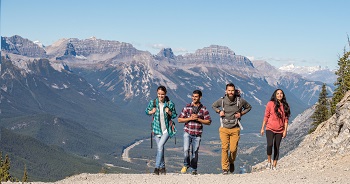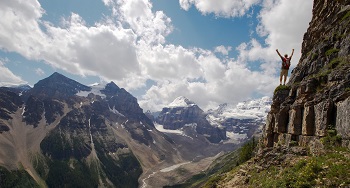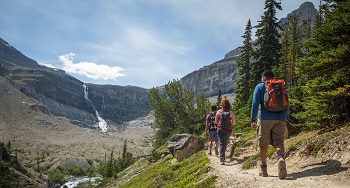
Hiking
Banff National Park
Watch the sunset on a riverside stroll or feel the breath of glaciers in the alpine. Take your pick of over 1,600 kilometres (1,000 miles) of maintained trails. Many of the park’s most famous hikes are easily accessible from the Town of Banff and the village of Lake Louise.
Prime hiking season runs July through mid-September. Until late June, many passes are still snow-bound and may be subject to avalanche hazard. Trails tend to be muddier at this time and the best hiking is at lower elevations or on drier, south facing slopes around the Town of Banff. By the middle of July, most alpine passes are snow-free.
Safety
Safety is your responsibility. There are always hazards associated with outdoor recreation. Even short trips from the town of Banff can have serious consequences.
- Check the weather forecast, current trail conditions, warnings and closures or visit a Parks Canada visitor centre.
- Be prepared for emergencies and changes in weather. Mountain weather changes quickly and it can snow any month of the year. Dress in layers, bring extra food and warm clothing.
- Study descriptions and maps before heading out. Always choose a trail suitable for the least experienced member in your group.
- Bring your own water. Surface water may be contaminated and unsafe for drinking.
- Carry a first aid kit, bear spray and a satellite emergency communication device like SpotX, inReach or Zoleo, and know how to use them.
- Tell a reliable person where you are going, when you will be back, and who to call if you do not return: Banff Dispatch – 403-762-1470.
- Ticks, which could carry Lyme disease may be present in the park. It is important to check yourself and your pet after hiking.
- Avoid wearing earbuds or headphones. Be alert at all times.
- In case of EMERGENCY, call 911 or satellite phone: 403-762-4506. Cell phone coverage is not reliable throughout the national park.

Snowy trails and season avalanche risk
Snow can remain on some trails well into the summer. When trails are snow covered, route finding can be difficult and travel through deep or hard snow or ice can be unsafe. Be prepared and check trail conditions before heading out.
Trails above tree line (2 000 m) may be exposed to avalanche hazard at any time of the year and especially from November through June. Snow on steep slopes has the potential to slide.
- Check the Avalanche Bulletin for the latest conditions.
- For more information visit a Parks Canada visitor centre or check the Mountain Safety section.
Wildlife
Banff National Park is home to wildlife including elk, wolves, cougars, grizzly bears and black bears. To successfully raise their young and sustain a healthy population, wildlife need access to as much quality habitat with as few human surprises as possible.
Be aware of possible encounters with wildlife in all areas of the park, including paved trails and roads.Tips:
- Always carry bear spray, ensure it is accessible, and know how to use it. Bear spray is available at the Banff visitor centres and retail outlets in Banff and Lake Louise.
- Make noise. Being quiet puts you at risk for sudden wildlife encounters. Be alert through shrubby areas, near running water and when approaching blind corners. Travel in tight groups and always be aware of your surroundings.
- Keep dogs on leash and under physical control at all times.
If you see a large carnivore, such as a bear, cougar, wolf or coyote, please report the sighting (when it is safe to do so) by calling Banff Dispatch at 1-403-762-1470.
More information
Recommended packing list
Trail guide and map
Full water bottle or thermos
High energy food
Bear spray
Sunscreen and sunglasses
First aid kit and emergency blanket
Headlamp or flashlight with spare batteries
Hat and gloves
Proper footwear
Hiking poles
Rain/wind jacket
Extra warm clothing in case of an emergency
Fully charged cell phone
Satellite emergency communication device like SpotX, inReach or Zoleo
Trail ratings
|
Easy |
|
|
Moderate |
|
|
|
|
Trail etiquette
Show courtesy to fellow trail users.
- Leave what you find —it is the law. Natural and cultural resources such as rocks, fossils, artifacts, horns, antlers, wildflowers and nests are protected and must be left undisturbed for others to discover and enjoy.
- If you are too far away to use the toilets provided at the trailheads, dispose of human waste at least 100 m from any water source. Bury solid human waste in a hole 15 cm deep. Pack out your toilet paper.
- To prevent damage to vegetation, stay on designated trails at all times.
- Trails are used by a variety of outdoor enthusiasts. Be sure to yield to others.
- Leave no trace. Pack out everything you pack in.
Roam Public Transit and shuttle services

Trails identified with a bus symbol indicate that the trailhead is accessible by Roam Public Transit and/or private shuttle service. Parking at trailheads is limited and fills quickly. For the best experience, take public transit or a shuttle.
- Date modified :




